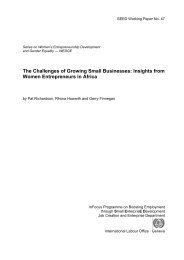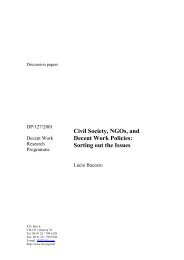manual: women workers' rights and gender equality - International ...
manual: women workers' rights and gender equality - International ...
manual: women workers' rights and gender equality - International ...
Create successful ePaper yourself
Turn your PDF publications into a flip-book with our unique Google optimized e-Paper software.
Exercise 14<br />
Step 1<br />
• Ask the participants if they know what HIV/AIDS is<br />
• Explain it briefly to the participants<br />
Step 2<br />
• Put the traffic light at a place where everybody sees it<br />
• Explain that red means: stop immediately with what you are doing; orange: think twice before<br />
you do it; <strong>and</strong> green: you can do what you want to do<br />
• Show the cards one by one <strong>and</strong> ask the participants whether the traffic light should be on red,<br />
orange or green if they do not want to run the risk to become infected with HIV/AIDS<br />
• Ask them why they have decided on each colour <strong>and</strong> if everybody agrees on it<br />
• See the tip for group work in the Notes for trainers, if you have the time to do this exercise in<br />
smaller groups, followed by discussion in plenary<br />
Step 3<br />
• When all cards are placed start a discussion using the following questions:<br />
- How can you get infected with HIV/AIDS?<br />
- Which behaviour is risky regarding HIV/AIDS infection?<br />
- What can you do to make the risk as small as possible?<br />
- How do you recognize someone who is infected?<br />
- How can you take care of people who are infected?<br />
Step 4<br />
• Tell the participants the following story:<br />
Sao <strong>and</strong> Chenda are a couple without children. Sao worked for a construction company until<br />
two months ago. He has been fired because he was often very ill. He went to see the doctor<br />
who examined him. The doctor sent him for a blood test. The results from the blood test are<br />
very clear: he is infected with HIV/AIDS. Most probably he will die soon. His wife tries to take<br />
care of him as well as she can. This is difficult because she has to go to work to earn the<br />
money they need so badly. Especially at the moment, because the medicines of Sao are very<br />
expensive. At her work, they found out that her husb<strong>and</strong> has been infected with HIV/AIDS. Her<br />
employer told Chenda that she has to get tested to prove that she is not infected; if she is, he<br />
will fire her.<br />
• Discuss the story using the following questions:<br />
- Do they think this situation is fair?<br />
- Why or why not?<br />
- What would they do in such a situation?<br />
- Can they mention other problems workers face in this type of situation?<br />
- What if Chenda has HIV/AIDS, can her employer fire her?<br />
- Why or why not?<br />
- Do they know of workers infected with HIV/AIDS who were treated in a discriminatory way?<br />
- If so, how?<br />
- What can be done in these situations?<br />
14 Based on the exercise “Stop, Think, Go” in: Friends tell Friends on the Streets by Greg Carl <strong>and</strong> Nonthathorn<br />
Chaiphech, Thai Red Cross AIDS Research Centre, Bangkok, 2000<br />
126

















